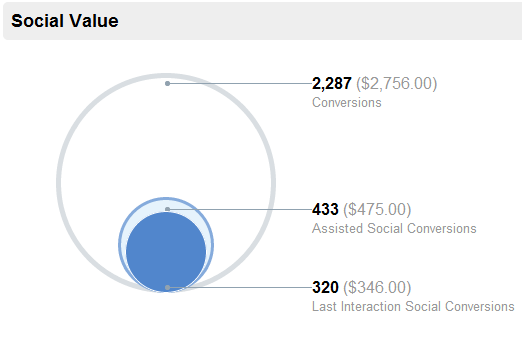Everyone is always asking about ROI
(Return on Investment) – and rightfully so. Marketers and their bosses need to
see hard data that reflects how their efforts are gaining or losing business. When
it comes to social media, it’s even more prevalent to know how social media
campaigns are turning a profit for a brand.
An article posted on gigaom.com about 3
accurate metrics for ROI on social media campaigns discusses three distinct
ways of measuring ROI:
- Social Media Revenue Conversion: “a measure of how many people become customers through social media referral channels.” In other words, web tracking allows for the measurement of referrals from various social media sites, either through traceable links or shared campaigns through third party apps (Wildfire App).
- Facebook engagement: “measures a brand’s ability to communicate successfully with their customers on the social network.” Similar to Google Analytics, Facebook Insights and a few other third party solutions tracks fan page engagement, content quality and overall sentiment
- Social customer support metrics: “measure the impact of customer support on brand health and the cost of staffing a social support program.” Along with the previous point, customer support is key to providing real time response to customer inquiries, which directly correlates with how successful a brand is in social media. The more positive the sentiment, the greater potential for growth. The more negative the sentiment, the greater potential for failure and a negative sentiment with a brand’s audience.
Google Analytics Now Measures Social Interactions
While there is no direct way to create
a social media effort and it automatically track its profit, Google Analytics
has done a great job in developing a tool for measuring Social.
Its latest update now has the ability
to calculate the “social value”, primarily when goals are E-commerce based, through
a myriad of metrics and calculations.
Its new tools incorporate various tracking
parameters to measure conversions from social actions (Likes, Tweets, Shares,
Pins, referral source, etc.), which then provides a value to said social
actions.
Calculating Social Value
ConvinceandConvert.com
has a great article, which details the new tool and measuring social value.
 With pre-determined goals setup, a brand can see how conversions are valued
from top funnel to bottom funnel of the sales pipe.
With pre-determined goals setup, a brand can see how conversions are valued
from top funnel to bottom funnel of the sales pipe.
Google’s
Social Report allows marketers to see the full social value generated from
social channels. According to Google Analytics blog:
“Social Value visualization compares
the number and monetary value of all your goal completions against those that
resulted from social referrals - both as last interaction, and assisted.
A visit from a social referral may
result in conversion immediately or it may assist in a conversion that occurs
later on. Referrals that lead to conversions immediately are labeled as Last
Interaction Social Conversion. If a referral from a social source doesn’t
immediately generate a conversion, but the visitor returns later and converts,
the referral is included as an Assisted Social Conversion.”
The biggest takeaway from web metrics
and social media is how a brand implements the various tools to measure its
successes and areas of improvement.
What we want to avoid is developing RAMs
(Random Acts of Marketing), which can be costly mistakes. Worse off, they are
immeasurable and can prove to be a short-term solution to a long-term problem.
Any smart marketer’s first step is to
research and identify the proper tools that can measure the various points of a
marketing campaign. Then, take things off from there.

No comments:
Post a Comment